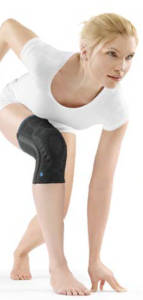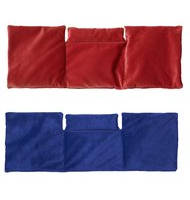Compression therapy
The power of controlled pressure
The basic treatment in the case of venous problems and disease of the lymphatic system is compression therapy. The latter is also used as a therapy accompanying other forms of treatment and as prophylaxis.
By means of compression therapy a precisely defined level of mechanical pressure is applied externally to the distended vessels and the leg. The compression stocking presses the veins together and thus reduces the diameter of the vein. The diseased venous valves close again and prevent reverse flow. Blood in the veins can now flow better and faster.
Compression treatment is boosted when the patient moves about as much as possible, for this activates the calf muscle pump. As a result, the deep leg veins are pressed together with each movement by the surrounding muscles. Below the muscle contraction blood flow is reduced, above it blood is carried in the direction of the heart. The deep veins are thus pressed empty from bottom to top, while the lower part is replenished with blood from the superficial veins.
Depending on the type of disease different options for compression treatment are available.

Compression stockings
In contrast to short-term treatment with compression bandages, medical compression stockings are designed for the long-term and permanent treatment of venous problems. They are used when the compression bandages have already relieved congestion. The stockings ensure the therapy results achieved so far and prevent any recurrence.
The leg may therefore not be (any longer) badly swollen because the leg’s circumference under the stocking would be reduced and the stocking would no longer fit. Only a stocking optimally fitted according to the leg measurements of the individual patient can guarantee that treatment will be successful. For this reason compression stockings are best measured by specialist dealers shortly after the patient gets up in the morning. Furthermore, stockings should be put on straight after getting up.
Additionally, to achieve the best possible effect, the compression of the stocking should be based on the individual medical problem and may not be equally high everywhere along the leg. As is the case with the bandage, the pressure of the compression stocking is strongest at the ankle and is reduced upwards in the direction of the heart. Below the knee it may be at most 70% and at the thigh only 40%. This accelerates blood flow to the heart and blood circulation in the leg improves perceptibly. To meet these requirements, stockings are available in a vast range of different sizes and lengths (knee length, semi-thigh, upper thigh, tights etc.).

Varicose vein

Vein with compression stockings
Compression classes
Medical compression stockings are divided into four different compression classes, differentiated according to the intensity of the resting pressure (the pressure that is applied to the leg when it is not moving). The compression classes are standardized on the basis of this level of resting pressure in the ankle area. However, not only resting pressure is decisive in determining the efficacy of the compression stockings but also the material which can vary in respect of stretchability and elasticity. For this reason there are stockings made of different materials in the different compression classes.
| Compression class | Compression class | Compression in kPA | Compression in mmHg |
|---|---|---|---|
| I | light | 2,4 to 2,8 | 18 to 21 |
| II | medium | 3,1 to 4,3 | 23 to 32 |
| III | strong | 4,5 to 6,1 | 34 to 46 |
| IV | very strong | 6,5 and greater | 49 and greater |
Who decides?
Which compression class and length the physician in the end decides on to treat his patient must be established on an individual basis. It in essence depends on the diagnostic findings and on the location of the disturbed drainage. A rigid classification of a compression class in response to a diagnosis makes little sense.
In order to ensure the compression stocking fits the patient’s leg, circumference and length must be exactly determined by specialist staff in a surgical supply store. There are measurement points that are precisely defined. For a 43 stocking, for example, there are set measurements. The size tables and leg measurements reveal whether the patient can be supplied with a standard product or whether he requires a made-to-measure version. The specialist dealer will provide the very best advice.
Compression bandages are used to treat for a short time fluid congestion in the limb. They are used in cases of acute venous or lymphatic disease because they can be replaced daily and adjusted to the appropriate pressure level. A distinction is made between bandages for the short or long term.
Long-term bandaging
Treatment in this case extends as a rule over several days and also nights.
The bandage is left on the leg throughout this period of time. When bandaging the leg, it is essential that the exact pressure level is observed, which may vary depending on the nature of the medical problem.
The bandage is applied either by the physician himself or by trained specialists.
Bandages are wrapped round the leg from bottom to top and may not squeeze nor sit loose nor crease nor constrict arteries.
Indentations and protruding joints are padded with cotton or special supports. The material consists of short stretch, zinc gel, zinc glue and adhesive bandages.
Short-term bandaging
When these bandages are used the patient only wears them during the day. They should be changed on a regular basis or at least be wrapped anew and consist of slightly elastic compression bandages.
This kind of therapy can only be successful if it is done rigorously and systematically and the patient does not discontinue the treatment.
Problems may on the one hand arise since the patient must actively support the therapy by changing bandages and having to keep frequent appointments with his physician. On the other hand, many patients feel embarrassed about the unattractive look of the bandage and are reluctant to appear in public.
This may lead to the patient discontinuing treatment and the desired effect not being achieved.





